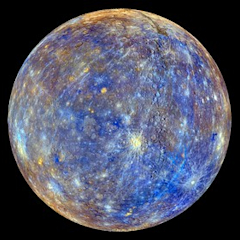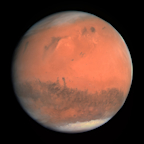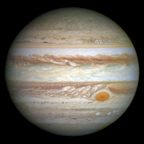Search results
Mercury is the first planet from the Sun and the smallest in the Solar System. In English, it is named after the ancient Roman god Mercurius ( Mercury ), god of commerce and communication, and the messenger of the gods. Mercury is classified as a terrestrial planet, with roughly the same surface gravity as Mars.
Apr 23, 2024 · Mercury, the innermost planet of the solar system and the eighth in size and mass. Its closeness to the Sun and its smallness make it the most elusive of the planets visible to the unaided eye . Because its rising or setting is always within about two hours of the Sun’s, it is never observable when the sky is fully dark.
Mercury—the smallest planet in our solar system and nearest to the Sun—is only slightly larger than Earth's Moon. Its surface is covered in tens of thousands of impact craters.
Apr 14, 2024 · Mercury is a planet of extremes. With a total volume little more than the Moon, it is the smallest planet in the Solar System and is situated the closest to the Sun. Mercury has no atmosphere...
Mercury is the smallest planet in the Solar System. One of five planets visible with the naked eye a, Mercury is just 4,879 Kilometres across its equator, compared with 12,742 Kilometres for the Earth. Mercury is the second densest planet. Even though the planet is small, Mercury is very dense.
Mercury Facts. The smallest planet in our solar system and nearest to the Sun, Mercury is only slightly larger than Earth's Moon. From the surface of Mercury, the Sun would appear more than three times as large as it does when viewed from Earth, and the sunlight would be as much as seven times brighter.
Jun 9, 2023 · Mercury is the closest planet to the sun and also the smallest planet in the solar system. The small and cratered planet does not have any moons and zips around the sun faster than any other...
May 6, 2024 · Isn't that wild? Credit: NASA/JPL-Caltech. Structure and Surface. Mercury is the smallest planet in our solar system. Mercury is a terrestrial planet. It is small and rocky. Mercury has a thin exosphere. Mercury’s surface can be as hot as 800 degrees F during the daytime and as cold as -300 degrees F during the nighttime.
Mercury has the shortest and fastest orbit around the Sun and experiences dramatic temperature changes as it rotates. It is a world of extremes. Explore facts about our solar system's fastest planet. Mercury facts. Equator circumference: 15,329km. Radius: 2,440km. Average distance from Sun: 58 million km. Surface temperature: -180°C to 430°C.
Mercury is a chemical element; it has symbol Hg and atomic number 80. It is also known as quicksilver and was formerly named hydrargyrum (/ h aɪ ˈ d r ɑːr dʒ ər ə m / hy-DRAR-jər-əm) from the Greek words hydor (water) and argyros (silver).



















